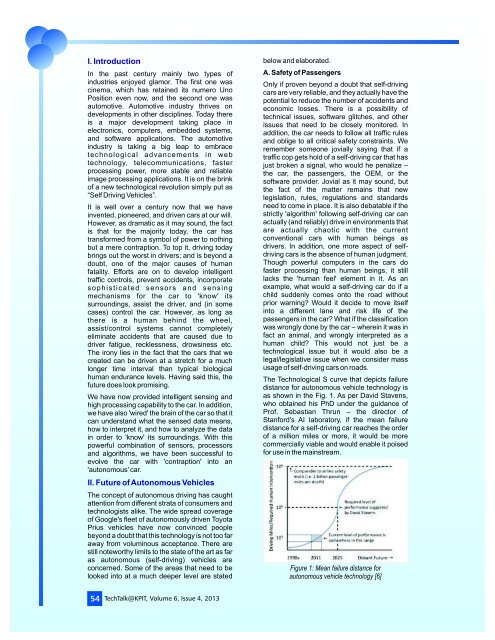Autonomous Vehicles - KPIT
Autonomous Vehicles - KPIT
Autonomous Vehicles - KPIT
You also want an ePaper? Increase the reach of your titles
YUMPU automatically turns print PDFs into web optimized ePapers that Google loves.
I. Introduction<br />
In the past century mainly two types of<br />
industries enjoyed glamor. The first one was<br />
cinema, which has retained its numero Uno<br />
Position even now, and the second one was<br />
automotive. Automotive industry thrives on<br />
developments in other disciplines. Today there<br />
is a major development taking place in<br />
electronics, computers, embedded systems,<br />
and software applications. The automotive<br />
industry is taking a big leap to embrace<br />
technological advancements in web<br />
technology, telecommunications, faster<br />
processing power, more stable and reliable<br />
image processing applications. It is on the brink<br />
of a new technological revolution simply put as<br />
“Self Driving <strong>Vehicles</strong>”.<br />
It is well over a century now that we have<br />
invented, pioneered, and driven cars at our will.<br />
However, as dramatic as it may sound, the fact<br />
is that for the majority today, the car has<br />
transformed from a symbol of power to nothing<br />
but a mere contraption. To top it, driving today<br />
brings out the worst in drivers; and is beyond a<br />
doubt, one of the major causes of human<br />
fatality. Efforts are on to develop intelligent<br />
traffic controls, prevent accidents, incorporate<br />
s o p h i s t i c a t e d s e n s o r s a n d s e n s i n g<br />
mechanisms for the car to 'know' its<br />
surroundings, assist the driver, and (in some<br />
cases) control the car. However, as long as<br />
there is a human behind the wheel,<br />
assist/control systems cannot completely<br />
eliminate accidents that are caused due to<br />
driver fatigue, recklessness, drowsiness etc.<br />
The irony lies in the fact that the cars that we<br />
created can be driven at a stretch for a much<br />
longer time interval than typical biological<br />
human endurance levels. Having said this, the<br />
future does look promising.<br />
We have now provided intelligent sensing and<br />
high processing capability to the car. In addition,<br />
we have also 'wired' the brain of the car so that it<br />
can understand what the sensed data means,<br />
how to interpret it, and how to analyze the data<br />
in order to 'know' its surroundings. With this<br />
powerful combination of sensors, processors<br />
and algorithms, we have been successful to<br />
evolve the car with 'contraption' into an<br />
'autonomous' car.<br />
II. Future of <strong>Autonomous</strong> <strong>Vehicles</strong><br />
The concept of autonomous driving has caught<br />
attention from different strata of consumers and<br />
technologists alike. The wide spread coverage<br />
of Google's fleet of autonomously driven Toyota<br />
Prius vehicles have now convinced people<br />
beyond a doubt that this technology is not too far<br />
away from voluminous acceptance. There are<br />
still noteworthy limits to the state of the art as far<br />
as autonomous (self-driving) vehicles are<br />
concerned. Some of the areas that need to be<br />
looked into at a much deeper level are stated<br />
below and elaborated.<br />
A. Safety of Passengers<br />
Only if proven beyond a doubt that self-driving<br />
cars are very reliable, and they actually have the<br />
potential to reduce the number of accidents and<br />
economic losses. There is a possibility of<br />
technical issues, software glitches, and other<br />
issues that need to be closely monitored. In<br />
addition, the car needs to follow all traffic rules<br />
and oblige to all critical safety constraints. We<br />
remember someone jovially saying that if a<br />
traffic cop gets hold of a self-driving car that has<br />
just broken a signal, who would he penalize –<br />
the car, the passengers, the OEM, or the<br />
software provider. Jovial as it may sound, but<br />
the fact of the matter remains that new<br />
legislation, rules, regulations and standards<br />
need to come in place. It is also debatable if the<br />
strictly 'algorithm' following self-driving car can<br />
actually (and reliably) drive in environments that<br />
are actually chaotic with the current<br />
conventional cars with human beings as<br />
drivers. In addition, one more aspect of selfdriving<br />
cars is the absence of human judgment.<br />
Though powerful computers in the cars do<br />
faster processing than human beings, it still<br />
lacks the 'human feel' element in it. As an<br />
example, what would a self-driving car do if a<br />
child suddenly comes onto the road without<br />
prior warning? Would it decide to move itself<br />
into a different lane and risk life of the<br />
passengers in the car? What if the classification<br />
was wrongly done by the car – wherein it was in<br />
fact an animal, and wrongly interpreted as a<br />
human child? This would not just be a<br />
technological issue but it would also be a<br />
legal/legislative issue when we consider mass<br />
usage of self-driving cars on roads.<br />
The Technological S curve that depicts failure<br />
distance for autonomous vehicle technology is<br />
as shown in the Fig. 1. As per David Stavens,<br />
who obtained his PhD under the guidance of<br />
Prof. Sebastian Thrun – the director of<br />
Stanford's AI laboratory, if the mean failure<br />
distance for a self-driving car reaches the order<br />
of a million miles or more, it would be more<br />
commercially viable and would enable it poised<br />
for use in the mainstream.<br />
Figure 1: Mean failure distance for<br />
autonomous vehicle technology [6]<br />
54 TechTalk@<strong>KPIT</strong>, Volume 6, Issue 4, 2013


